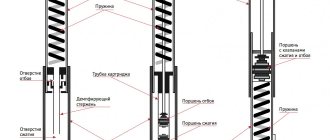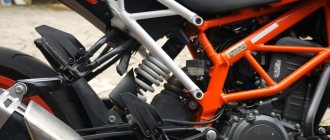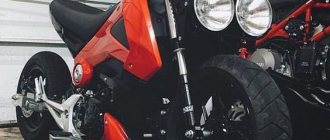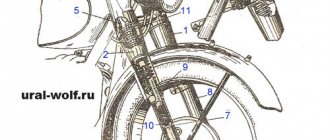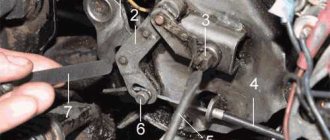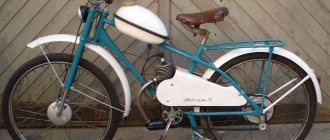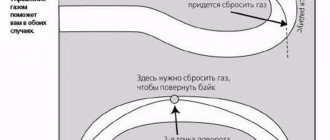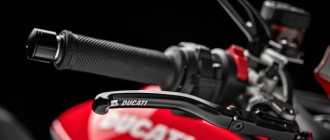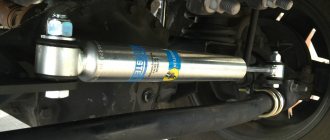For a long period of time, most cars were produced with power steering: the option has become so firmly established that many car enthusiasts cannot imagine driving without it.
But progress does not stand still, and the GURU is being replaced by electric power steering, which has a more compact design, can work even when the engine is turned off, and also helps save fuel by turning on only at the required moments. Despite the seemingly obvious advantages, manufacturers are in no hurry to install this mechanism en masse on their models, and there are certain reasons for this.
Power steering hydraulic system
It’s worth starting with this option, because it was the first to appear on cars and has still not lost its relevance.
Principle of operation
: Very simple, here the main working fluid is a special liquid, which is often poured into. The steering rack itself is a hollow cylinder into which a piston goes, attached to the steering shaft (to exaggerate it, it looks very much like a pharmaceutical syringe). A special pump pumps oil pressure in one direction or the other, and this piston begins to deviate in one direction or the other, accordingly helping you turn the steering wheel. There is approximately 0.5 - 1 liter of oil in the system, it is pumped by a pump that is driven by the engine crankshaft, that is, they are connected by a belt drive. Of course, the system contains metal and rubber tubes through which the working fluid actually pumps.
A few words about EGUR
. That's why electric power steering is now starting to appear. What does it mean? The differences are few, but they are significant - here, instead of a belt pump, an electric motor is used, that is, electricity is simply supplied and it pumps oil in the system. Thus, taking much less power and saving up to 0.5 - 0.7 liters per 100 km. Well, now it’s time to think about the pros and cons of this device
Pros of GUR
- Controllability. The driver has good feedback from the road; in terms of response accuracy and response, power steering comes first
- Great effort. Such amplifiers are installed on many HEAVY trucks; all electrical systems are not yet fully adapted
- Comfortable handling at both low and high speeds
- Now there are new generation devices with electric pumps that do not use a belt drive and save fuel
- There are no complex electronic sensors, we can call this system analog (except for power steering)
- Reliability is at a fairly high level, if you monitor it and change it on time, it can last a very long time
In general, there are not many complaints about this system; it still works stably, accurately and, importantly, can “turn” heavy truck racks. However, there are also a lot of negative aspects
Cons of GUR
- Takes up quite a lot of space under the hood (pipes, pump, rack itself) all this is quite cumbersome
- It has a special oil that needs to be changed after a certain number of kilometers, otherwise it may break down. Because oil seals can wear out faster
If the model is old (belt), it increases fuel consumption by up to 10% (if compared with the opponent). Because it additionally creates a load on the engine (pressure is built up thanks to a belt drive that comes from the crankshaft, respectively, part of the engine energy is spent on the hydraulic booster). Even at idle
- At low temperatures, you need to use it more carefully, it is advisable to warm it up
- If there is a leak or oil has leaked out, then you cannot operate the car! Or very limited mileage. Otherwise, the pump itself that pumps the oil may break.
- Repairs are sometimes very expensive. Although almost all service stations do this, there is nothing particularly complicated here
As you can see, the disadvantages of this system are also significant, especially power take-off and fuel consumption. After all, if you have a small-volume engine, it’s already “dead,” and then it also takes away the hydraulic booster.
What is the difference between power steering and electric power steering and which is better?
Now let’s compare these types of amplifiers with each other and try to determine which is better: hydraulics or electricity?
Let's start with the design features. The hydraulic booster is quite simple in structure, it is not afraid of malfunctions in the ECU. However, its anthers and hoses, as well as all kinds of seals, connections and other elements wear out relatively quickly. In addition, you need to monitor the fluid level in the power steering system. The electric amplifier is distinguished by greater durability and independence from consumables. Failures in the car’s electronic system can disrupt its operation, but they happen quite rarely. And if such a problem manifests itself, then problems with the EUR will probably be the least of the problems. Both types of mechanisms have an emergency mode of use.
Let's move on to ease of use. As practice shows, hydraulic boosters of even the simplest designs are more informative than electronic systems. They provide better connection with the road surface and make it possible to experience the maximum capabilities of the car when taking sharp turns. The EUR is theoretically also capable of this, but for this it must be carefully calibrated, which is done only on premium cars. In general, the hydraulic booster provides a highly informative and natural driving experience - however, it requires more physical strength than the electrical system.
Next, we will consider amplifiers from the point of view of efficiency and reliability. During operation, power steering consumes the power of the car's engine, which is why its appetite increases and its dynamic characteristics deteriorate. In addition, it is sensitive to high loads: it is not recommended to hold the steering wheel in extreme positions for more than 15 seconds, otherwise the pump may fail. The electric booster is driven by its own motor. Under increased loads, it can also overheat, but the automation in this case will reduce its performance or turn it off until the temperature drops.
The scope of application of the power steering is higher; it can be used both on a city minicar and on a multi-ton truck. The EUR is much weaker and therefore suitable only for passenger cars (and even then not for all).
Therefore, it is impossible to give a clear answer to the question of which is better power steering or electric steering. The latter was developed as a replacement for the hydraulic system, devoid of its inherent disadvantages, so for a number of factors it is definitely better. At the same time, power steering has a significantly wider scope of application and at the same time a lower price. Therefore, preference should be given to one option or another solely taking into account personal preferences and the characteristics of the desired car.
Which is better - hydraulic or electric power steering?
Most automakers are increasingly opting for an electric amplifier. There are a sufficient number of reasons for this:
- small dimensions of the entire structure;
- high accuracy and information content when driving a car;
- simplicity of the electric amplifier, a small number of malfunctions during operation;
- simple maintenance that does not require monitoring the oil level and condition of drives and hoses;
- The power steering does not allow you to keep the wheels in extreme positions for more than five seconds, otherwise there is a high risk of oil overheating and damage to the device.
Hydraulic power steering, along with its complexity, also differs in its dependence on the engine, which leads to an overall increase in fuel consumption. The figure is relatively small - no more than 0.5 liters per hundred, but it is also important for many motorists. It is worth noting another not particularly pleasant feature of the power steering - not the highest accuracy. To perform a sharp maneuver, you will have to twist the steering wheel many times.
Thanks to the advent of electric power steering, it has become possible to equip the vehicle with additional options that increase safety and comfort for the driver. These include a system that helps to park automatically, maintain traffic lanes, etc. The exchange rate stability system of a modern vehicle also uses electric power steering.
The output of the block operates directly on the phase windings of the motor, usually asynchronous. Power is supplied via two contacts, from the ignition switch and from the battery terminal, through a powerful fuse installed in the mounting block.
Electric power steering operating principle
The working fluid fills the reservoir and then goes to the power steering pump through the connecting hose. When you turn the steering wheel, the control unit supplies power to the electric motor, which turns on and begins to rotate the power steering pump shaft at a frequency depending on the vehicle speed and the force applied to the steering wheel. Power is also supplied to the corresponding solenoid valve, depending on the direction of rotation. The pump creates fluid pressure and transfers it through the corresponding valve to the hydraulic cylinder. The hydraulic cylinder, using the energy of the working fluid, generates a force proportional to the pressure of the fluid, which moves the piston and rod, then they turn the wheels in the desired way using a system of levers.
The main reasons for pump failure:
Untimely replacement of the working fluid in the system. Using a low-quality liquid or one that is not suitable for this car model. Ingress of dirt or foreign bodies (a clot of oily dust that usually accumulates around the oil reservoir cap is a common cause of pump failure). Lack of tightness and, as a result, leakage of working fluid. After which the system becomes airy and fails. Oil starvation due to kinks in oil lines. Significant overheating of the system, or systematic minor overheating. Errors during installation, poor quality assembly. During operation, the power steering pump parts, as they wear out, saturate the working fluid of the system with metal dust or even small metal particles. When the time comes to replace the old power steering pump with a new one, the entire power steering system must be thoroughly flushed, and elements in which wear products have accumulated must also be replaced. If you ignore this instruction, you risk that the new pump will be damaged as soon as possible.
admin 02/04/2015
“If you notice an error in the text, please highlight this place with the mouse and press CTRL+ENTER” “If the article was useful to you, share the link to it on social networks”
Benefits of driving with power steering
- the amplifier takes the lion's share of the load onto itself;
- there is no need for a large number of turns of the steering wheel, it does not break out of your hands;
- the feeling of road unevenness is softened;
- the machine is easier to control, maneuverability increases; difficult turns can be made without effort;
- taxiing at low speeds becomes more convenient;
- the trajectory of movement is stabilized;
- if the front tire is punctured, it is easier to hold the car;
- the driver is less stressed and does not get tired;
- This is especially true if the driver is a woman;
- The wear resistance of the steering mechanism increases and its service life is extended.
All this ensures the most safe and comfortable driving (provided the car is in good technical condition).
A potential danger arises only in an emergency situation - a sudden failure (breakdown) of the power steering system when turning while driving. In this case, the reaction, knowledge and experience of the driver become crucial. Problems can be signaled by extraneous noises, vibrations, sharp jolts, turning the steering wheel, turning it difficult or too easy.
According to statistics, a quarter of Russian drivers prefer power steering, and half prefer electric power steering (and the indicators are biased in favor of electric power steering). The advantages of each of these mechanisms are determined by their design features.
Modern cars use electric power steering, hydraulic power steering and electric power steering.
Pros and cons of EUR
The advantages of EUR are the following nuances:
- it does not require the power of a car engine to operate;
- fuel is saved to a certain extent;
- the electronic mechanism is quite compact;
- the system does not use liquids, so operation is simplified;
- the EUR design does not contain damage-sensitive hoses, boots, etc.;
- The steering system, equipped with an electric booster, always works clearly, without losing the sharpness of its response.
The disadvantages of electric power steering include the following:
- high price - EUR is significantly more expensive than power steering;
- the complexity and high cost of repairs, although the service life of such units is quite large;
- low power, which is why heavy jeeps, trucks and other heavy vehicles are not equipped with electric boosters.
EPS malfunction
EPS fault pictogram
If the warning light on the instrument panel (the icon with the steering wheel with an exclamation mark) comes on, this indicates an EPS malfunction. The appearance of an error indicates that the electric amplifier does not undergo self-diagnosis when the ignition is turned on. The cause of the malfunction can be many factors, for example, the failure of any of the sensors included in the EPS control system. Although you can drive a car without an electric booster, you should not do this. It's better to turn to specialists.
Efficiency and reliability
Using power steering forces the car to lose some of its power - it goes to drive the pump, which can have quite large needs. Therefore, the use of power steering inevitably leads to a deterioration in dynamic parameters and a significant increase in fuel consumption with other comparable parameters. Moreover, even with constant movement in a straight line, the situation does not improve at all - the pump works constantly, moving oil through the high and low pressure pipes.
Every motorist should know that the hydraulic booster cannot withstand operation in extreme conditions for a long time - if the steering wheel is held in the extreme position for 10-15 seconds, the pump will overheat, as a result of which the unit will completely shut down. To restart it, you need to turn off the car, wait a few minutes and start it again, carefully moving the steering wheel from the extreme position to the zero point.
Electric boosters are considered more economical - they do not take engine power directly, but only create additional load on the generator. In addition, the electric booster only works when the wheels are turning, and when moving along a straight path, the motor remains completely switched off - it does not worsen the dynamic characteristics of the car and does not create additional ones. Also, when turning the steering wheel to its extreme position, heating will occur only when the steering wheel is rotated very quickly in different directions, which can only be done on purpose.
However, turning off the electric boosters cannot be called a rarity - this mainly happens when driving off-road or on roads covered with viscous, loose snow. After some time, the unit will give an alarm, after which its performance will be limited and the driver will see a warning, and if driving continues under similar conditions, the amplifier will turn off until the motor has completely cooled.
Advantages of electric power steering
- Ease of steering with electric steering (“one finger”). Excellent maneuverability when parking, quick adaptation to changes in speed.
- Settings of power steering parameters for various operating modes. (Crosswind stabilization, car parking)
- Width of temperature range for EUR. The fluid in the power steering can freeze and boil under the influence of temperatures and overloads.
- Simplicity of design and maintenance of the EUR. You just need to monitor the condition of the bearings. Power steering maintenance is more labor-intensive. Regular inspection is required for integrity, monitoring the tightness of hydraulic tubes, checking the tension of the drive belt, and the oil level. There are rules for changing the oil and filter.
- Compact dimensions of the EUR.
- Economical efficiency of electric power steering (less fuel consumption, higher efficiency).
- Operation of the machine after disconnecting the faulty power steering. This is undesirable for power steering (the steering is destroyed; other breakdowns may occur).
- The ability to hold the steering wheel in the extreme position for a long time with ESD. On cars with power steering, a delay of more than 5 seconds threatens serious damage.
- Environmental friendliness of the EUR. Cars with power steering produce more harmful emissions; power steering units that have expired are more difficult to dispose of.
- Serious prospects for progress of ESD.
Basic modes
The electric power steering has two main modes. They are characterized by the speed of the vehicle. In the first mode, when driving at low speed, for example, during parking, when greater maneuverability is required and the steering wheel has to be turned to the extreme positions, either left or right, the ESD applies maximum force to the steering mechanism, providing “light steering.” In this mode, you can rotate the steering wheel with one finger.
On the contrary, when driving at high speeds, the steering wheel becomes “hard”, creating the effect of the wheels returning to the middle position. This is done in order to improve traffic safety.
There are also modes for holding the car on the road in strong crosswinds, when driving on wheels, with different degrees of pumping. These modes are achieved thanks to special settings of the control unit. On business and premium class cars, the presence of an electric steering system allows you to implement the automatic parking option.
Pros and cons of power steering
The undoubted advantages of hydraulic boosters include the following:
- adaptability to high loads, which allows the use of power steering on heavy vehicles, including trucks;
- relative cheapness, which also affects the overall cost of the car;
- ease of machine control over a wide speed range;
- relative ease of maintenance and availability of repairs;
Power steering also has its disadvantages:
- engine power is used to operate the pump;
- the seals are easily damaged, as a result of which the system begins to leak;
- the efficiency of the hydraulic booster directly depends on the level of fluid in its reservoir;
- the fluid needs to be changed periodically;
- Power steering does not make it possible to individually adjust the performance characteristics of the steering system.
Device and main components
Main components of electric power steering
EPS Servotronic consists of three main components: an electronic control system, a pump unit and a hydraulic control unit.
The pumping unit of the electro-hydraulic booster consists of a reservoir for working fluid, a hydraulic pump and an electric motor for it. An electronic control unit (ECU) is installed on this component. Note that there are two types of electric pump: gear and vane. The first type of pump is distinguished by its simplicity and reliability.
The hydraulic control unit includes a power cylinder with a piston and a torsion bar (rod that works to twist) with a distribution sleeve and spool. This component is integrated with the steering mechanism. The hydraulic unit is the actuator of the amplifier.
Electric power steering or EPS
EPS is an electric power steering in which the force necessary to turn the wheels is created by an electric motor. A peculiarity of systems of this type is that they are mounted directly on the steering rack or column. For comparison: power steering is often installed as a separate system.
The main structural elements of the EUR are:
- electric motor;
- torsion bar;
- steering shaft;
- gearbox;
- steering position and angle sensor;
- torque sensor;
- Control block;
- toothed gears.
When the driver turns the steering wheel, the torsion bar twists. The torque created in this case is recorded by a corresponding sensor, in which the received information is interpreted into a signal supplied to the electronic control unit. Here, this data is analyzed and compared with information transmitted from other sensors, including the speedometer, tachometer, etc. Based on the results of the analysis, the ECU determines the force required to turn the steering wheel and sends a command to the electric motor. As it rotates, it transmits its rotation to the steering shaft or directly to the steering rack.
About additional functions of electric amplifiers
The electric power steering device is designed in such a way that, if necessary, the electric motor can turn the car's wheels both simultaneously with the driver and independently. This gives scope for the implementation of additional functions:
- automatic “steering” to keep the car on a straight path;
- returning the wheels to a straight position after making a maneuver, the EUR can do this when the driver releases the steering wheel after making a turn;
- creating “heaviness” on the steering wheel in different driving modes to make the steering wheel more informative;
- perform automatic parking without driver intervention.
At the same time, the EUR does not interfere with direct control of the wheels when the engine is turned off or broken down; the mechanical connection between them and the steering wheel is maintained.
Comparative characteristics
Disadvantages of electric power steering and advantages of power steering:
- There is sensitivity of the EUR to bad (sloppy, bumpy) roads and moisture (in particular, in bad weather - when there is snow, rain, puddles). In such cases, there is a danger of overheating and shutdown, as well as burnout.
- The power steering better smooths out shocks when the road is uneven and when hitting a curb.
- The EUR does not provide an immediate response if the wheels quickly turn in the other direction. And if you twist the steering wheel sharply, the system may turn off altogether.
- There are more possibilities for self-repair for power steering.
- In the case of electric power steering, the possibility of electronic failure cannot be ruled out (however, this mainly occurs in old and cheap models; another reason is non-compliance with operating rules).
- Production of power steering is less expensive; their price is lower than that of the EUR.
- The EUR is limited for installation on heavy trucks and SUVs (due to lack of power).
EUR electric power steering
It was created as a more advanced and simpler system (and is still being improved). It has a lot of varieties, at least read it.
Principle of operation
: Again, in a nutshell - everything is simply taken by an electric motor, connected to a shaft (on which there are special grooves, or a screw, or just splines) and this electric motor pushes this shaft to the right or left.
The only difference between electric amplifiers is that the electric motor can be attached to different parts of the steering mechanism:
- On the steering column
- On the rack shaft itself (I use a spline connection)
- Parallel to the steering column shaft (twin shaft systems)
- Using a ball nut
Ask why there are so many different mechanisms - it’s all because you haven’t yet achieved the normal effort and accuracy of “steering” like your opponent. Although the last type with a ball nut came very close to this.
Of course, the EURA has no liquid, no hoses and tubes, no pump - it is very compact, which often allows it to be mounted even on the steering column.
However, the negative side here is the presence of various sensors and other electronics, but everything is in order
Positive aspects of the electric booster
- The driver has sufficient effort and contact with the road
- Has two positions. City and highway. In city mode, the steering wheel is lighter, which contributes to comfortable driving. In the “road” mode, it turns off already at 40–60 km/h, which was done on purpose; at high speeds, an amplifier is not needed. Therefore the feedback is increased.
- Fuel economy. There is no additional load on the engine because it has no belt drives and is powered by electricity from a generator (battery). If the car is stationary and the steering wheel does not turn, it does not work. Activated only when turning. Allows you to save up to 10% fuel
- It takes up little space under the hood and in the cabin. Since it is technically simpler (and more compact) than power steering
- It has no liquid and, accordingly, is practically maintenance-free
- Has a wide temperature range of use. For example, in winter there is no need to heat it. Even a few seconds
- If it breaks, you can move freely, but the steering wheel will become heavier, at least you will always get to the service station
- Many electronic autopilot (autoparking) systems work only with electric power steering
- AT THE MOMENT - RELIABLE, not inferior in quality to the hydraulic booster
As you can see, there are really a lot of positive aspects, some of them don’t even know that they have an electric booster until it reaches 150 – 200,000 km, because there are simply no cans or other parts under the hood. I like that lately it has been tuned quite precisely, that is, it is beginning to be similar in “steering” accuracy to its opponent. However, it is still far from it, yet there are also a lot of disadvantages here
Negative points of EURA
Repairs are expensive and difficult to diagnose. Ordinary service stations often simply do not know what is broken, there are simply oxides on the contacts and such an amplifier is already faulty. You need special diagnostic tools to read errors. Also, the blocks here are often not repaired, but replaced as an assembly. If the engine is damaged, it is often cast with either a steering rack or a column; they are replaced together. AND THIS IS EXPENSIVE!
- If moisture gets under the protective covers, it may malfunction.
- Since it uses electricity, it requires the installation of a more powerful generator and complex wiring
- The first models sometimes “glitched”, turned in the wrong direction, and did not work clearly. True, this only happened on our VAZs
How does the EUR work?
The entire device is divided into electrical and mechanical parts, the connection between which is made through sensors and an electric motor with a gearbox.
The composition includes the following elements:
- an executive servo drive, consisting of an electric motor and a gearbox, which is needed due to the fairly high speed of the electric motor shaft;
- a control unit having inputs from sensors, external devices and outputs to the power motor;
- sensors that generate signals for the direction of rotation of the steering wheel, the force on the steering shaft and the speed of its rotation.
The EUR receives power from the vehicle's on-board network; if the electronics are turned off due to a malfunction, the steering mechanism continues to work, but without power.
Principle of operation
In the initial state, the electric motor does not operate and no energy is consumed. The control unit monitors the sensor signals and, if it detects actions from the driver, begins to control the electric motor.
The more the torsion bar torque sensor on the steering column is twisted, the greater the force created by the servo drive, which compensates for the feedback from the steering linkage to the driver’s hands. The direction of turn, the speed of the driver’s actions and the angle of deflection of the steered wheels are monitored.
In parking mode, when the speed is low, the gain should be maximum; the steering wheel can be rotated at high speed through significant angles without encountering resistance.
However, as speed increases, the steering wheel should become heavier, on the one hand warning the driver about the inadmissibility of sudden movements, and on the other hand, providing important force feedback that allows one to control the traction of the wheels with the road.
The EUR must monitor the return of the wheels to the neutral position, which is not always possible with high friction in the mechanisms. Moreover, this function does not work all the time; in parking modes, return and variable gain are not required.
On the contrary, when interacting with the stabilization system, vigorous self-reset is necessary to stabilize the vehicle in directional direction, even if the driver has lost control. Preemptive actions are also carried out, similar to how an experienced driver takes a car out of skids and drifts.
In autonomous control, the ESD becomes the actuator for lane marking tracking, automatic obstacle avoidance and adaptive cruise control when cornering. Warning signals in the form of shocks and vibrations can be transmitted through it.
Types of construction
The ESD servo drive can be built into the steering column or directly into the steering mechanism. The first solution is used on light budget cars, and the second on more massive or sporty ones.
Direct connection with the steering rack is provided by a separate screw, worm or gear transmission, separate from the steering shaft gear-rack pair.
This way you can transmit significant force and do it as accurately as possible. But the price of the device also increases.
Scheme
The electric power steering circuit includes a control unit, a connector with phase contacts of the electric motor, two connectors for torque and position sensors, a power cable connected to the main mounting block of the car, an interface connector for communication with controllers of other systems and the dashboard.
The input signals are:
- vehicle speed sensor;
- steering direction sensor;
- strain gauge torque sensor on the steering column;
- steering speed sensor where this information is used;
- bidirectional diagnostic signal;
- tachometer signal;
The output of the block operates directly on the phase windings of the motor, usually asynchronous. Power is supplied via two contacts, from the ignition switch and from the battery terminal, through a powerful fuse installed in the mounting block.
A separate stabilized power supply circuit for the sensors is formed in the control unit.
Electric booster with parallel shaft-coupling drive
Ease of management
From the point of view of convenience of the steering system, hydraulic boosters remain unsurpassed today. They provide better feedback and allow the driver to feel what the car's limits are in tight corners. In addition, the hydraulic booster is almost insensitive to vibrations and shocks, so it does not need special protection from poor road surfaces.
Promotion: Sale of new cars 2018-2019 at the Moscow Automobile House
Sale of new cars produced in 2018-2019 Sale of used cars Trade-in Credit from 9.9%
It is more comfortable to drive a car with power steering
In practice, this means that the motorist not only senses the vehicle's capabilities and can detect the moment of loss of control, but can also perceive all the flaws of bad asphalt. Thanks to this, serviceable hydraulic boosters create almost the same sensations as when using cars without any additional components in the steering.
The electric booster needs careful calibration to provide similar sensations - currently, only manufacturers operating in the premium segment can make control as convenient as possible. In addition, the electric motor used in such a circuit has a fairly high sensitivity to shock loads and vibration - they can significantly reduce its service life. Therefore, to protect the unit from damage, the steering shaft is equipped with a special damper that dampens vibrations.
Electric power steering is comfortable only in the premium segment
It would seem that control should become more convenient without shaking the steering wheel, but many automotive experts and simply car owners note that they experience severe discomfort when using an electric booster with non-ideal settings. According to reviews, driving such a car is more like a computer game, since the driver does not feel any feedback or shocks when driving along sections of the road with poor surfaces - although in expensive cars there is no such unpleasant effect.
Technologies
The only way to fine-tune the hydraulic booster is to use a rack with a progressive gear ratio. It helps to create some heaviness when turning the steering wheel at a small angle, which helps to increase the stability of the car when driving at a fairly high speed. However, when the steering wheel deviates from the zero position over a long distance, the force decreases significantly, which makes parking easier in a large city.
In addition, the manufacturer can vary the pump performance, but it must be kept within a fairly narrow range to prevent damage to the unit due to overload and not to make the force too small. That is why manufacturers of premium cars prefer a well-tuned electric booster.
The hydraulic booster consists of many parts
In turn, it can change its performance on the fly - the first time a circuit with the ability to switch steering sensitivity modes has been tested in motorsport. In addition, a special program can be written into the electric power steering control unit, which will simulate a change in the gear ratio - this does not even require the use of more expensive and difficult-to-manufacture racks. That is why in many modern electric amplifiers you can select several operating modes:
The electric booster settings can be changed on the go, if such a function is provided by the manufacturer - to do this, just press a special button or select the appropriate item in the electronic control system menu.
Electric power steering is weak for heavy vehicles
This situation will continue in the near future, since it takes a lot of time to develop compact motors with high torque and long service life. Some developers tried to use alternative schemes in which the electric power amplifier is located separately from the steering shaft - and they could use any engines. However, such a system was considered unpromising, since it does not have any great advantages over the hydraulic booster, which has a lower production cost.
Differences from other types of amplifiers
As noted earlier, unlike a conventional power steering, the Servotronic electric power steering system contains an electric motor that drives a pump (or another actuator - a solenoid valve), as well as an electronic control system. These design differences allow the electro-hydraulic booster to adjust the force depending on the speed of the machine. This ensures comfortable and safe driving at any speed.
Separately, we note the ease of maneuvering at low speeds, which is inaccessible to conventional power steering. At higher speeds, the gain level is reduced, allowing the driver to control the vehicle more accurately.
Bottom line
It seems to me that progress is inexorably moving towards electric amplifier options, this is inevitable
If only because all modern systems, such as “steering” and keeping the car in the lane, auto parking, and other autopilots cannot work with the hydraulic version, it simply does not have an electric motor that they can control! Also, the EUR is more economical, less fuel is consumed, which is very important for the environment. Its reliability is the same, that is, both options can last a long time
That is why now many manufacturers, not only European, but also Japanese and Korean, are switching to electric units in passenger cars.
Although two important problems need to be solved, these are control accuracy (it is higher on power steering) and installation on heavy trucks. Now this is practically impossible, because electric motors mounted in a rail are heavy and energy-hungry.
If you now buy an inexpensive car in the city for an ordinary person, and even a small car (you drive at low speeds), then look towards the EUR. If the car is of a higher class, has higher speeds, and you need precision control, then you can consider power steering.
Now we are watching the video version
power steering
EUR
Bottom line
Some power steering imperfections have been eliminated in models with electric power steering: efficiency has increased, it has become possible to set the necessary parameters, and the drive belt has been replaced with an electric motor. But the future still lies with electromechanical power steering. This is a worldwide trend because their benefits are obvious.
- Next Mud tires for Niva and other SUVs: how to choose the right one
- Back Popular compact SUVs: choosing the best SUV for Russia
- News / Ratings
Oct 3, 2019
- Oct 3, 2019
- Oct 2, 2019
- 1 Oct, 2019
- BMW Crossovers / News
Sep 30, 2019
- Sep 30, 2019
- April 13, 2019
- March 12, 2019
- Feb 17, 2019
- News/Reference information
Jun 22, 2019
- April 11, 2019
